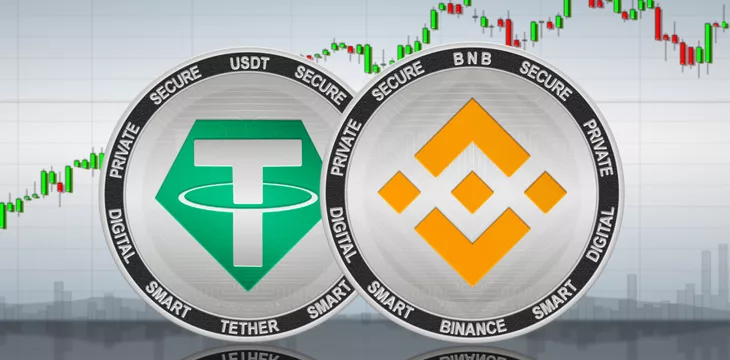|
Getting your Trinity Audio player ready...
|
The next ‘crypto’ bell that tolls will almost certainly spell trouble for the Tether (USDT)
stablecoin, with significant repercussions for the wider digital asset sector.
The fallout from Tuesday’s record-setting plea agreements between U.S. federal agencies, the Binance exchange, and its founder, Changpeng ‘CZ’ Zhao, is still spreading across the digital asset ecosystem. In announcing the Binance/CZ guilty pleas for money laundering and Bank Secrecy Act violations, Attorney General Merrick Garland warned other entities that “using new technology to break the law does not make you a disruptor, it makes you a criminal.”
The Treasury Department’s Financial Crimes Enforcement Network (FinCEN) says Binance “was aware” of “a substantial volume of suspicious transactions” passing through Binance accounts. These suspect transactions involved “ransomware, terrorist financing, high-risk jurisdictions, darknet markets and scams, and child sexual abuse material [CSAM].” FinCEN identified “well over a hundred thousand suspicious transactions that Binance failed to timely and accurately report.”
Among the more jarring of these lapses was the “over a thousand” direct BTC and ETH
transactions “worth hundreds of thousands of dollars” linked with “child exploitation-associated CVC [convertible virtual currency] wallet addresses, including at least three separate marketplaces dealing in [CSAM].”
In March 2020, the Department of Justice (DOJ) indicted an administrator of one of these marketplaces, Dark Scandals, and while Binance “took internal action to address Dark Scandals,” the exchange still failed to file any related SARs with FinCEN. Even after the indictment was made public, Binance failed to file any SARs, hindering investigations that might have prevented additional CSAM activity.
FinCEN spells it out plainly: “Binance’s incomplete responses and patently unreasonable delays in providing readily available information reflect its disdain for regulatory obligations.” Remember those CSAM victims the next time some Binance bro tries to claim that ‘no customers got hurt’ as a result of their ‘see no evil’ mindset.
Binance won’t be able to dodge its compliance responsibilities now. Among the requirements of Binance’s $4.3 billion settlement was the establishment of an independent third-party monitor and a suspicious activity report [SAR] Lookback Consultant, who will be granted unprecedented access to Binance’s transaction records for 2018 through 2022.
The consent order issued by FinCEN specifies the sweeping powers these monitors will enjoy for the next five years and the severe penalties Binance could face if it attempts to obstruct this monitor’s activities. The Lookback Consultant must deliver a detailed report on its findings no later than May 2025.
The consent order notes that Binance has “five primary CVC trading pairs,” specifically, BTC, ETH, LTC, USDT, and Binance’s in-house BNB token. The monitor has been tasked with considering the risks of various Binance policies, including “the types of CVC products and services, including AECs [anonymity enhanced coins], that Binance offers its customers.”
On that note…
The Cumberland gap
USDT, particularly when issued on Justin Sun’s Tron blockchain, has been singled out by members of Congress as the preferred digital asset of terror groups, including Hamas and Palestinian Islamic Jihad (PIJ). Tether has been repeatedly linked to money laundering, human slavery, bank fraud, and other crimes in jurisdictions across the globe by individuals and entities who don’t want their activities monitored by U.S. financial watchdogs.
Binance was among the biggest recipients of USDT, the market cap of which is now brushing close to a record $89 billion. That’s up by nearly $2 billion in just the past week. In fact, another billion was minted on Tron the day after CZ entered his plea. They might be crooks, but the Tether crew either (a) don’t lack for balls or (b) do lack for brains.
In late 2021, Protos demonstrated that market-maker Cumberland Global—an offshoot of Chicago-based trading firm DRW—was among the largest recipients of USDT issued up to that date. Subsequent research showed Cumberland sent nearly $19 billion worth of USDT—four-fifths of all USDT issued to Cumberland—directly to Binance for market-making purposes.
Cumberland is referenced in the consent order as Binance’s ‘Customer B,’ which continued to deal with Binance’s primary dot-com exchange “until late 2022, well after Binance purported to have implemented enhanced controls to identify and offboard U.S. users.”
Given Cumberland’s Chicago roots, U.S. federal agencies will have ample opportunity to compel the company to open its kimono and expose what lurks beneath. Among the more pressing questions these agencies will be interested in learning is whether Cumberland actually sent a dollar to Tether for every single USDT it received from Tether. Should those numbers not align perfectly—and they definitely haven’t on multiple occasions—a fraud case would prove a slam dunk.
Proactively reacting
Having long taken a similarly disdainful approach to regulatory compliance, Tether has of late demonstrated a growing awareness of the legal peril it finds itself in. This has contributed to Tether’s belated desire to be seen cooperating with U.S. authorities to disrupt the flow of illicit USDT-based activity.
On Monday, Tether issued a press release describing the great service it had provided the DOJ by “proactively and voluntarily freezing” $225 million worth of USDT in wallets “linked to an international human trafficking syndicate in Southeast Asia responsible for a global ‘pig butchering’ romance scam.” (Pig butchering is when the marks are slowly but steadily milked by fake online paramours until the marks either catch on or are bled dry.)
Tether claims it and the OKX exchange participated in a “months-long investigative effort” with U.S. law enforcement agencies that was almost certainly not initiated by Tether. The freeze request came from the U.S. Secret Service (USSS), absent which Tether would probably not have even known about the scam, let alone taken any action to halt it.
In fact, ChainArgos noted that the frozen wallets held over $300 million in USDT just one week before Tether’s breathless PR. A swifter response might have preserved more than $75 million of stolen assets. But that’s not what Tether wants you to focus on. In case the message was unclear, Tether used variations of the word ‘proactive’ to describe its actions no less than six times in the release.
The DOJ issued its own release the following day describing the seizure of “nearly $9 million” in USDT alleged to have been stolen from over 70 victims of ‘pig butchering’ scams. The DoJ credited the USSS with the actual investigation and tracing of the victims’ assets. The sole mention of Tether’s allegedly ‘proactive’ efforts was a brief acknowledgment that Tether assisted in “effectuating the transfer of these assets.”
Damned if you do (anything)
Desperate to sustain any positive PR momentum, Tether issued another release following the DOJ’s release, claiming to have “recently onboarded the [USSS] into its platform and will be working with the Federal Bureau of Investigation to do the same.” Tether CEO Paolo Ardoino claimed to “condemn the misuse of USDT or any cryptocurrency for illicit purposes.”
Binance used to issue similarly self-congratulatory claims like the ones above, while internal communications showed its compliance officers ribbing other staffers who dared to wonder what some of the exchange’s customers were up to. “Like come on. They are here for crime … we see the bad, but we close 2 eyes.” Bear that in mind while digesting Ardoino’s grandiose compliance claims.
Tether’s business model is no different from Binance’s. Without crime—be it drug trafficking, money laundering, or fraudulent wash trading to artificially inflate token prices—there’d be little use for USDT. But with Binance admitting its guilt and contractually bound to cooperate with U.S. law enforcement on any and all investigations of digital asset operators, Tether suddenly finds itself between a rock and a hard place.
The rock is the long, muscular arm of U.S. law. The hard place is represented by the criminal organizations that rely on USDT to keep their operations in business. Tether can’t satisfy the demands of U.S. law enforcement without pissing off a whole lot of very dangerous people. No wonder Tether’s original CEO, Jean-Louis van der Velde, was so eager to hand the keys to Tether’s corner office to Ardoino a month ago. Time to do a Homer, Paolo.
Follow CoinGeek’s Crypto Crime Cartel series, which delves into the stream of groups—from BitMEX to Binance, Bitcoin.com, Blockstream, ShapeShift, Coinbase, Ripple,
Ethereum, FTX and Tether—who have co-opted the digital asset revolution and turned the industry into a minefield for naïve (and even experienced) players in the market.

 04-18-2025
04-18-2025 





